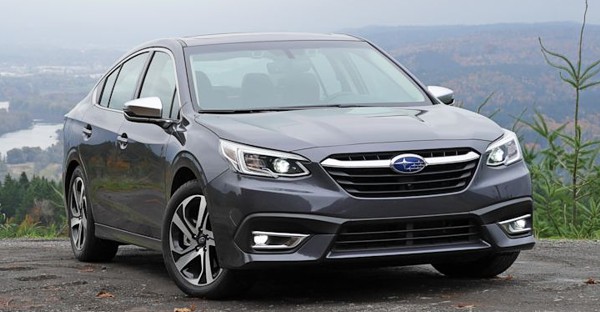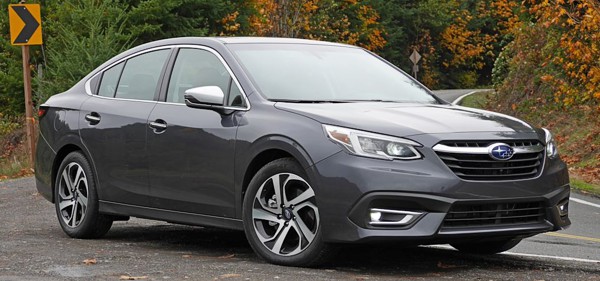Published
on 12
Mar 2020
|
All rights reserved.
|
|
|

|
|
Once
a niche and sporty family car, the Legacy becomes conservative in
recent generations.
|
|
In the last fiscal year,
Subaru sold 260,000 units of Legacy and its crossover wagon derivative,
Outback. This means one in four Subarus are the Legacy series. The
Legacy has always been a niche offering in the mainstream family car
segment. It ignores the market trend and persists in using boxer
engines and permanent all-wheel drive – the latter makes it especially
popular in the snowbelt of North America. The latest generation is no
exception.
The outgoing Legacy was not very successful. It was outsold by its
Outback sibling by 4 to 1. The rise of crossover trend might be a main
reason, but I suppose the Legacy’s boring look was equally responsible.
Coming to the new generation, we see a slight improvement. While the
exterior is still tall and boxy and conservative, contrasting to the
low-slung look of Toyota Camry, Honda Accord and Mazda 6, at least its
sheet metal has more curves in the form of crease lines. The reshaped
front grille, head and tail-lights try to look less dull, although the
effect is limited. Overall speaking, this is still one of the least
interesting family cars to look. Subaru really needs to improve its
design capability.

|
|
70
percent boost of chassis rigidity pays off in refinement.
|
|
Size-wise, the new Legacy does not differ much from the old car. It is
45mm longer,
but keep the same width and height. Also unchanged is the 2750mm
wheelbase, which is a little short by class standard. It might sound
like to be
build on the old platform, but in fact it has switched to the new
Subaru Global Platform which debuted on the Mk5 Impreza a few years
back. The mechanical layout never changes, i.e. symmetric 4WD, boxer
engine, strut suspension up front and double-wishbone setup at the
back, but the chief improvement is structural rigidity. Thanks to using
more ultra-high strength steel, structural adhesives, foam-filled
crossmember and improved welding strategy, the monocoque body achieves
a whopping 70 percent increase of torsional rigidity. As a result, NVH
suppression, handling and ride are also improved. The suspension
features aluminum control arms up front and hollow anti-roll bars front
and back to cut unsprung weight, optimizing ride comfort.
On the road, it is evident that the new Legacy is a lot more refined.
The ride is plush. The cabin is quiet, with little wind and road noise
penetrated. On the downside, it is short of driver appeal. You might
think the combination of boxer engine and permanent 4WD should be a
dream to drive. Unfortunately, the big Subaru is not designed with keen
drivers in mind. It is heavy and comfort-oriented. Its roadholding is
poor, blame to mediocre all-seasons tires. Its steering is too light.
Its soft suspension setting leads to a lot of body roll in corner, and
it
bounces over mid-corner bumps. It lacks the composure of many rivals.
Although inherent balance is good and understeer is mild, the Legacy
does not
encourage you to drive fast. It asks you to relax and enjoy its new
found refinement.

|
|
While
refinement is high, dynamics are weak, driver appeal is lacking.
|
|
The powertrains are also far from sporty. There are 2 boxer-four
engines available. The base engine is a familiar 2.5-liter naturally
aspirated unit, now features direct injection finally. It produces a
class-norm 182 hp and 176 lbft of torque, 6 horses and a scant 2 lbft
more than before. As the Legacy is on the heavy side of the class, its
performance is poorer than the
class average, taking over 8 seconds to accelerate from rest to 60
mph. In the global trend of turbocharging, it feels terribly
slow, especially when responding to overtaking. The Lineartronic CVT
does not help either. Although Subaru’s chain-driven CVT is one of the
better of its kind, it still drones the engine under hard acceleration,
amplifying the boxer engine’s coarse noise.
The premium engine is a 2.4-liter turbo, replacing the old car’s
3.6-liter six-cylinder boxer. It produces 4 more horsepower at 260, but
even more important is boosting torque by 30 lbft to 277 lbft. It takes
just over 6 seconds to go from 0-60, a full second quicker than the old
motor. Flexibility is stronger, yet fuel economy is improved, almost
matching the naturally aspirated engine. With stronger torque across
the band, the
new engine tends to spin slower hence quieter. Unfortunately, it is
again ruined by that CVT, which seems to have problem to deal with the
stronger torque. Throttle response is painfully slow, with a noticeable
delay before the power picks up. The automatic stop-start feature is
also far from seamless. Whenever the boxer engine restarts, there is a
noticeable vibration and even jump start. These small problems add to
the perception of an unpolished product.

|
|
Large
touch screen is easy to read and use.
|
|
The least complained area is the cabin. The Legacy stands out with an
11.6-inch portrait touch screen, whose size makes reading and access
easy. Its response is decent and the software interface is easy to use.
The
dashboard design is certainly more stylish than the old car’s, while
materials are vastly improved. Soft plastics, Nappa leather upholstery
with contrast stitching and faux alloy trims are extensively used on
the premium trims, although the cheaper plastics or fit and finish are
still no match for Camry or Accord. The seats are comfortable. Space is
abundant for 4 or 5 adults despite the shorter wheelbase. You sit
higher in the Legacy, have a better view outside thanks to larger
windows. As the car is tall, all passengers still enjoy good amount of
headroom.
The Legacy seems to be developed with a budget far smaller than the
giant Toyota, Honda and Nissan spending on their big-selling family
cars. This is
evident in its lack of polish, as well as the conservative engineering
approach. It has no ambition to be a class-leader or an innovator in
any areas. It follows the same old formula, just improves the
weaknesses and keep up with the market trend. The upside is a
competitive pricing, which matches the equivalent Camry, Accord and
Altima, but gives 4WD for free.
|
Verdict:    |
|